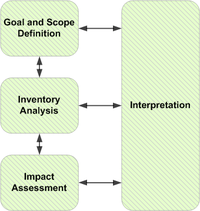
Photo from wikipedia
Photovoltaic systems represent a leading part of the market in the renewable energies sector. Contemporary technology offers possibilities to improve systems converting sun energy, especially for the efficiency of modules.… Click to show full abstract
Photovoltaic systems represent a leading part of the market in the renewable energies sector. Contemporary technology offers possibilities to improve systems converting sun energy, especially for the efficiency of modules. The paper focuses on current concentrated photovoltaic (CPV) technologies, presenting data for solar cells and modules working under lab conditions as well as in a real environment. In this paper, we consider up-to-date solutions for two types of concentrating photovoltaic systems: high-concentration photovoltaics (HCPV) and low-concentration photovoltaics (LCPV). The current status of CPV solar modules was complemented by the preliminary results of new hybrid photovoltaic technology achieving records in efficiency. Compared to traditional Si-PV panels, CPV modules achieve greater conversion efficiency as a result of the concentrator optics applied. Specific CPV technologies were described in terms of efficiency, new approaches of a multijunction solar cell, a tracking system, and durability. The results of the analysis prove intensive development in the field of CPV modules and the potential of achieving record system efficiency. The paper also presents methods for the determination of the environmental impact of CPV during the entire life cycle by life cycle assessment (LCA) analysis and possible waste management scenarios. Environmental performance is generally assessed based on standard indicators, such as energy payback time, CO2 footprint, or GHG emission.
Journal Title: Energies
Year Published: 2021
Link to full text (if available)
Share on Social Media: Sign Up to like & get
recommendations!